First post, by MaxWar
- Rank
- Oldbie
Alright folks, the time has come to reveal the data acquired from the audio blind test experiment that was started a week ago.
As the title implies, the subject of this study was:
Discrete Vs. Integrated YM3438.
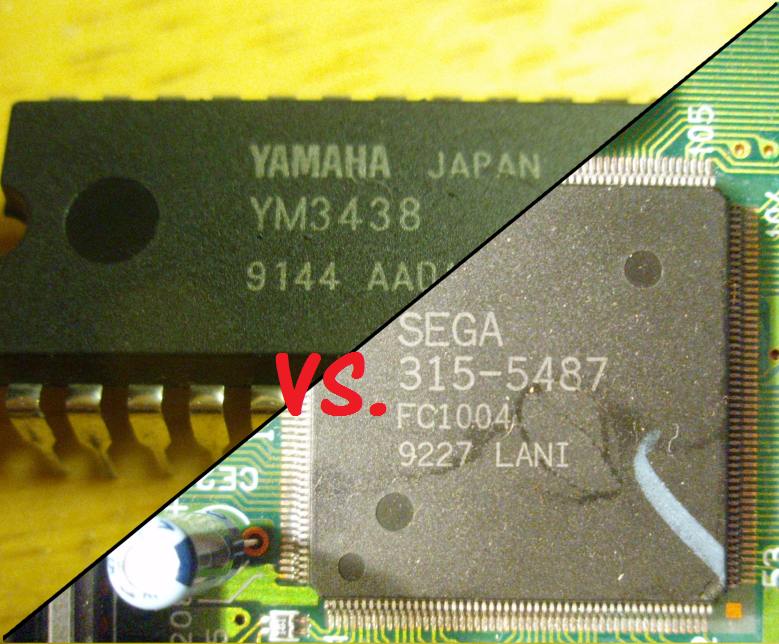
The goal was to evaluate if these two chips sound significantly different from each other and if so, which one was preferred.
I wrote a load of details and explanations so most questions you might have about the test are likely explained down there.
I also added lots of pictures so hopefully its a good read and you do not get that TL;DR feeling. But if you still do, you can skip right to the results and conclusion, I guess...
Background Information:
On the original Sega genesis model 1, the FM audio chip is the Yamaha YM2612. This is a digital FM synthesizer with an integrated DAC ( digital to analog converter). This DAC was the main flaw of this chip as it introduced a lot of noisy artifacts during the conversion.
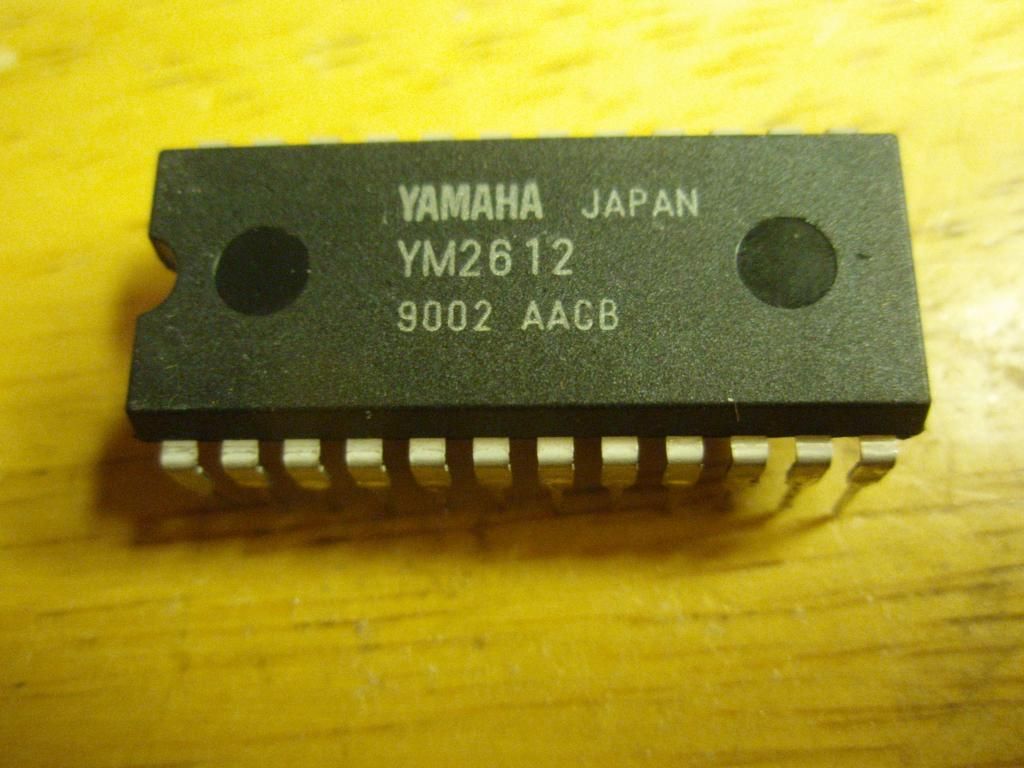
Yamaha then developed the YM3438, which is basically a CMOS version of the YM2612 but they also improved the DAC. This new DAC greatly reduced the amount of processing noise/aliasing in the sound.
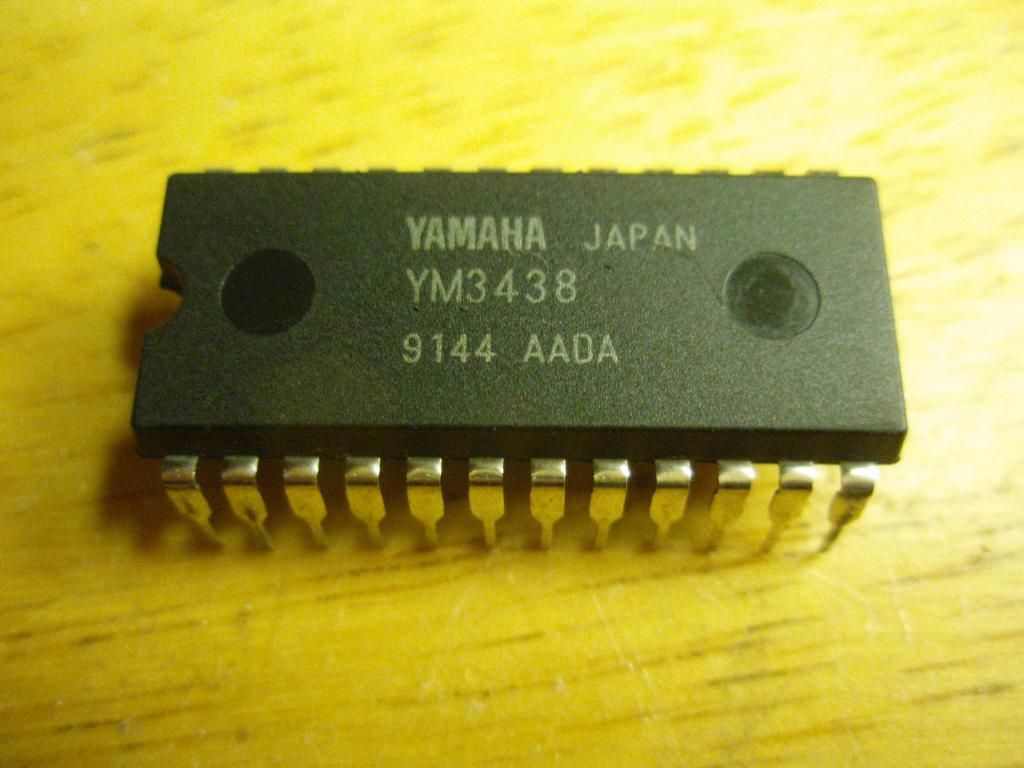
The stand alone YM3438 chip ( or discrete ) seen above was never used in a Sega genesis console however. Instead Sega integrated the new YM3438 FM synthesizer inside a large general purpose ASIC, the FC1004. This chip was used in the model 1 VA7 and model 2 VA0, VA1 and VA1.8 revisions of the genesis console.
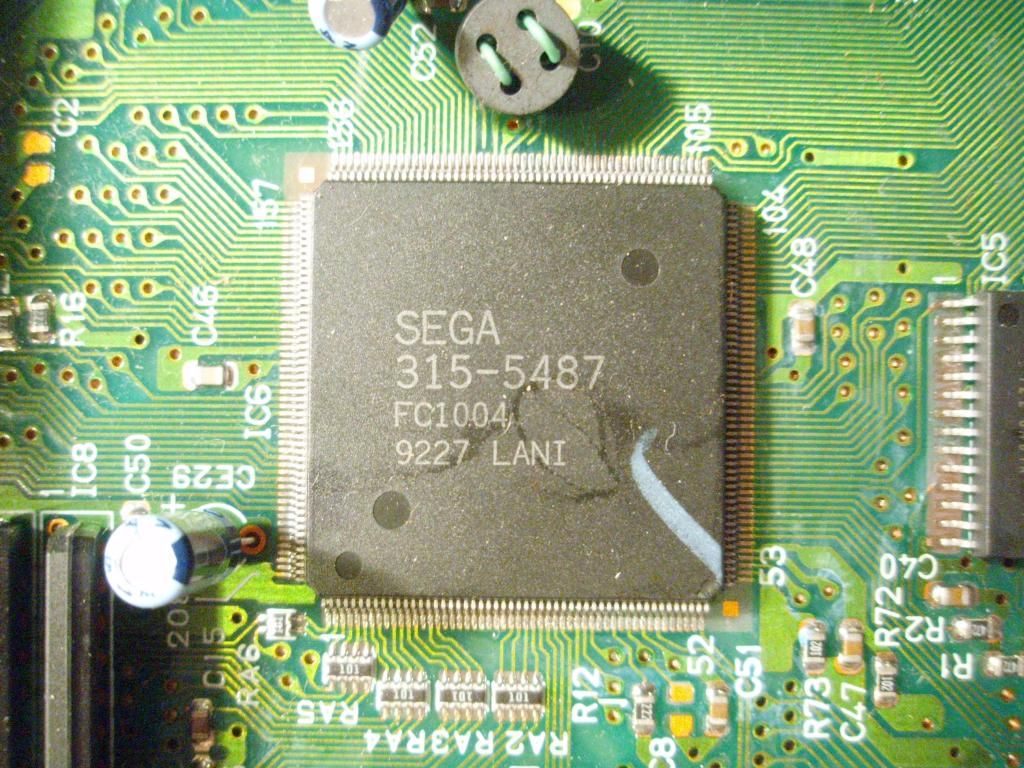
Now the interesting part is that supposedly, the DAC was even further improved in this model and it removed the Bit depth truncation associated with the Ym2612 and Ym3438. You can read about this on wiki: http://en.wikipedia.org/wiki/Yamaha_YM2612. So basically this would mean that the Sega Integrated YM3438 (FC1004) is the best version of the 3438 ever made. At least according to the literature.
The Crystal Clear audio mod. (CCAM)
Ok So basically the best version of the FM chip is inside the early model 2 consoles, which ironically are renowned for having the worse sound!
The horrible quality of the sound however has nothing to do with the chip but rather with the lackluster amplification circuit Sega used in those consoles.
This is what Tiido Priimägi wanted to fix when he started developing the Crystal clear audio mod years ago. I am sure most of you have at least heard about this mod. It is a pretty complex mod so only few people as of now benefit from it. Basically it takes your crappy early model 2 and turns it into the best sounding Sega Genesis possible. But you need to build this circuit first.

The important detail is that this circuit only works with the YM3438 ( ASIC YM2612 as Tiido put it back then), and not the discrete YM2612 of the model 1. The reason for this is that they have different type of outputs ( YM3438 is louder ). As a result this circuit was only to be used on model 2 consoles and did not work on model 1 consoles ( except VA7, which is basically a Model 2 in model 1 case ). This was not considered a major problem because the model 1 already had a decent amplification circuit. However those looking for the ultimate audio for the genesis would get a model 2 and a CCAM as this setup is much better than a stock model 1.
As of now there are no CCAM equivalent for the Model 1. While the amp in the model 1 is already pretty good, the main reason to this is that the YM2612 was considered inferior so most modders did not consider it worth the bother to develop a better amp for it.
Now what if we swap the YM2612 in the Model1 for a YM3438?
The two chips are pin compatible so in theory it is pretty simple to remove the YM2612 in a model 1 and install a YM3438 instead. But remember that the two versions of the chip output differently so If you simply swap them over your genesis 1 will output garbage as sound. The genesis 1 onboard amp is inadequate for the 3438.
AFAIK this problem had not really been assessed and documented until earlier this year when a few modders, EvilDragon and Drakon among possibly others got in their mind to make this work. This concluded with a YM3438 working in a genesis 1 using a modified model 1 amplifier.
While this experiment was successful in the end it mostly went under the radar and was seen as a curiosity rather than something actually useful. One of the main reason for this is that it was assumed that the Discrete YM3438 was significantly inferior to the YM3438 that is integrated in the model 2 genesis. In other words the the stand-alone discrete YM3438 was seen as pretty much an equivalent of the YM2612 while the true superior chip was the FC1004 found in the model 2.
This is where I came in and repeated that experiment myself. However instead of using a modified model 1 amplifier on the discrete YM3438 I used the CCAM amp. It immediately struck me that the discrete YM3438 was being underrated and in fact was much more similar to the integrated YM3438 than was popularly admitted.
I also knew that simply saying so would be seen as: "well, thats just your opinion" and that this would be lost in the immensity of the internet all the while people would continue to occasionally speculate about it.
So i went a bit nut and decided to make this a big deal and do this blind test experiment to once and for all go to the bottom of the question and substitute all the talk by actual facts!
The blind test and comparative recording methodology.
I do have some experience in comparative recording methodology. Actually, as far as i know, no one in the retro gaming/modding scene went as far as I did in perfectionism regarding to this. What I am doing is more akin to what is found in the professional audio industry and among hardcore audiophiles rather than the retrogaming circles.
I wrote a precise protocol for this, which I used before for comparing different sound cards, different Famicoms and even the impact of recapping systems on sound quality. Most of this protocol can be found here https://sites.google.com/site/soundcardcompar … ecording-method. I will answers questions about it if need be.
To sum it up the basic idea of the comparative recording recording methodology is to limit all external sources of variation as much as possible and leave what you want to compare as the only significant source of variation. Its pretty straightforward really.
Details on the hardware setups I used.
For this blind test experiment I had two consoles.
The first one is a standard Genesis model 2 VA1 with CCAM amplifer.
The second one is a Model 1 VA3 with its YM2612 chip replaced by a YM3438 and also uses the CCAM amplifier.
Both are recorded into audacity using the exact same presets and recording hardware and I used the very same CCAM circuit on both machines.
My CCAM circuit was made by RetroGamer343 from Sega16 and I modified it to have very little LowPass filtering, according to the original Tiido schematics.
Typically a CCAM amp is permanently installed into a console. However I wanted to use the very same circuit on several consoles so I made a modular setup.
Here you can see I mounted the CCAM PCB inside of a grounded tuna can which serves as a complete RF shield for the circuit. I installed RCA connectors on it, one side connects directly to the chip and the other side connects to the recording device.
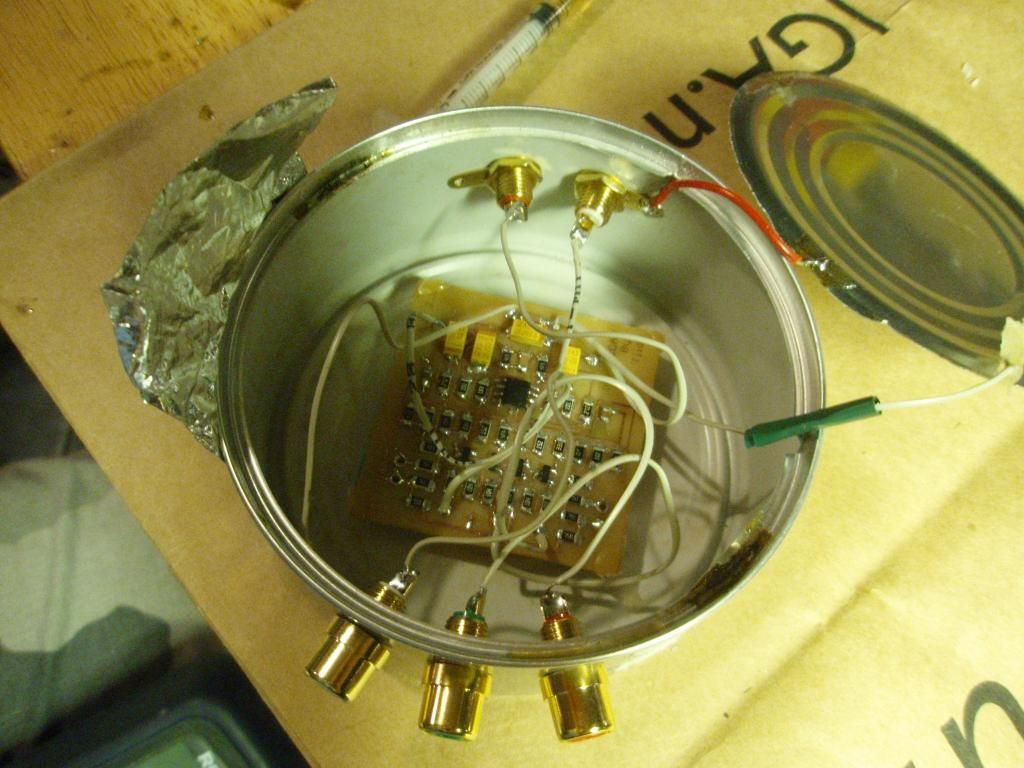
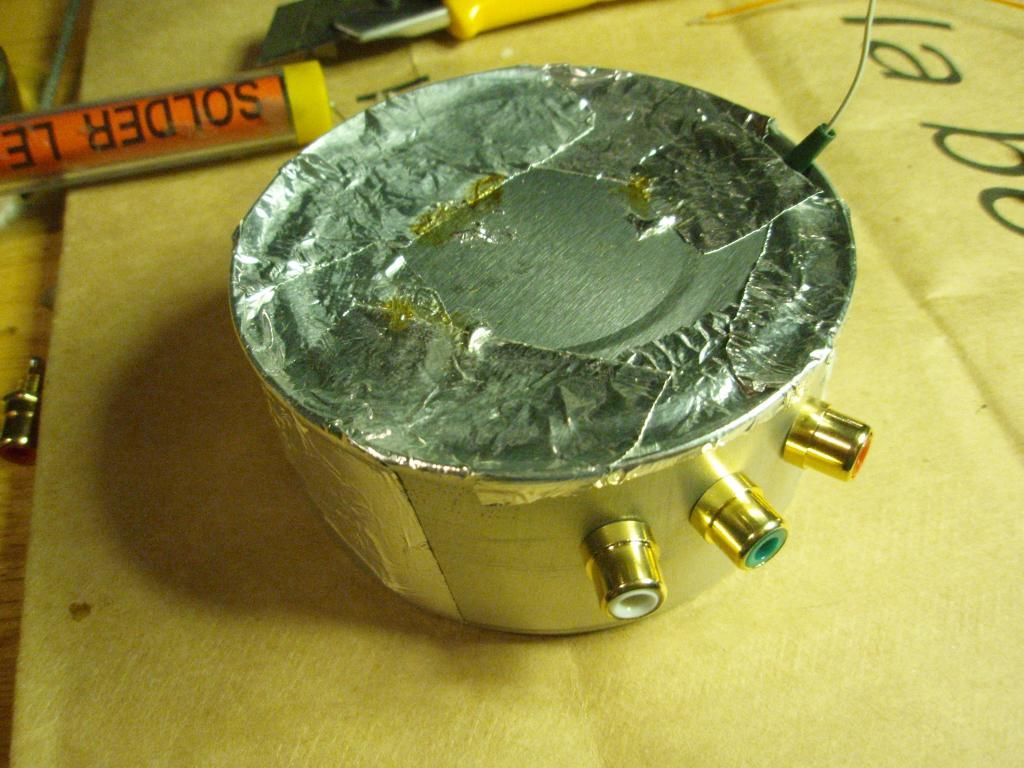
On the consoles side, all preparation was made in a consistent manner. The chip outputs were completely isolated from the motherboard either by cutting traces or removing components. The chip output was then connected directly to the CCAM and nothing else via fully grounded shielded cables.
Here is a close view of the connections on the Model 2 VA1.
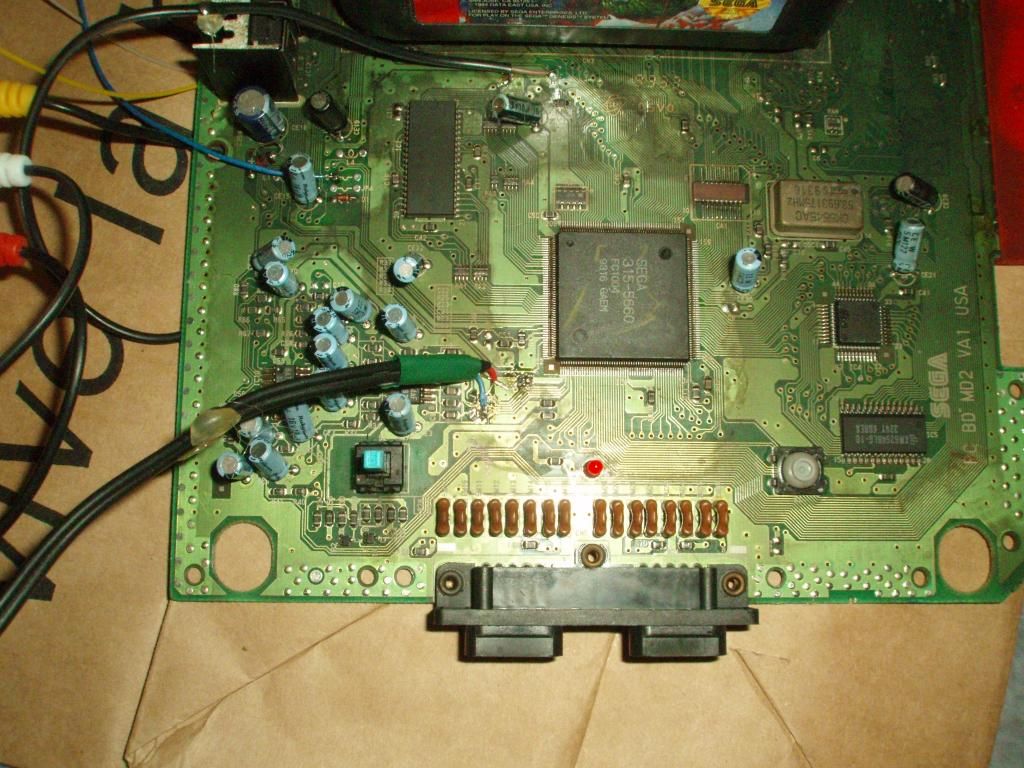
Here you can see that the YM3438 in my model 1 is installed in a socket and similarly connected with shielded cables. The PSG here is tapped on the underside of the board, unseen in this picture.
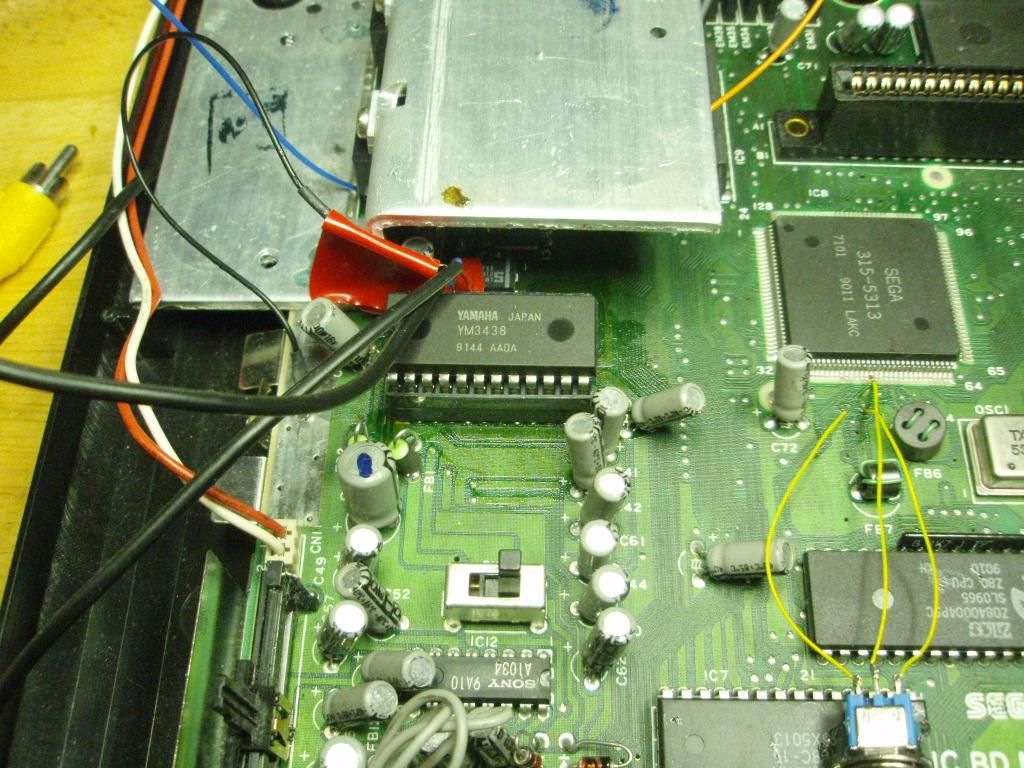
Here is a view of the complete model 1 setup just prior to recording.
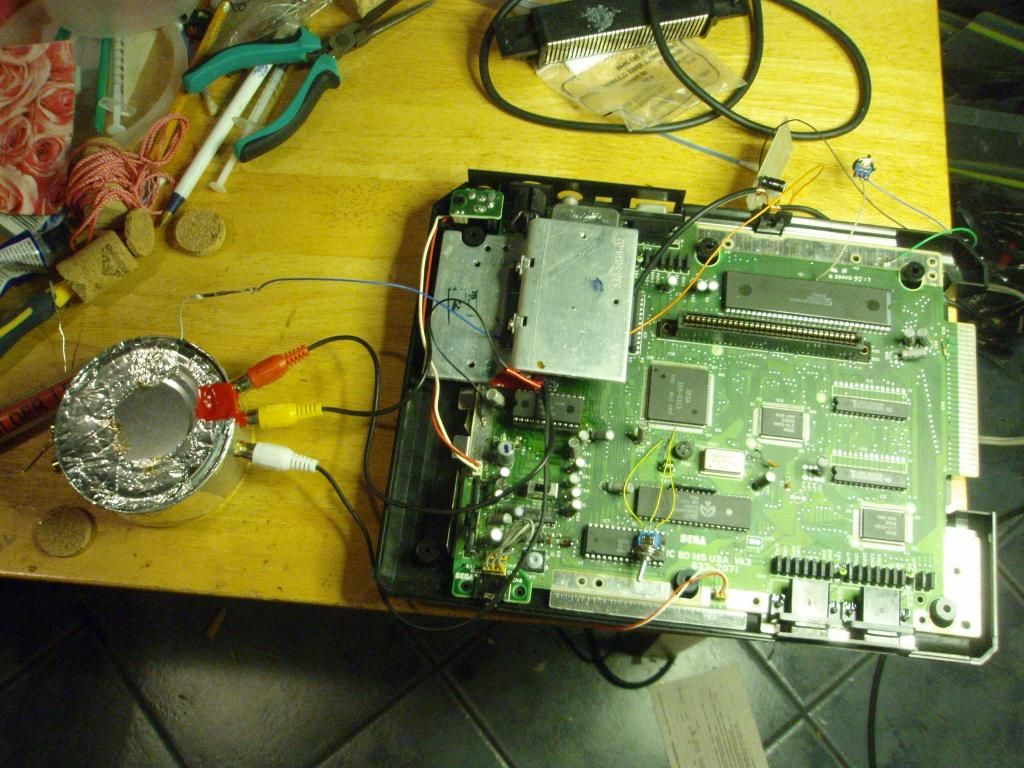
Blind test results:
First I will declare that these results are real and I did not falsify or modify any of the numbers. These are exactly what I received from the participants. While I think it is better to keep the choices and identity of indivitual participants anonymous, I still stand behind this data and rest my reputation and credibility on it as I know this is 100% genuine. If need be all the PMs I received could be verified by a third party and the data double checked. Furthermore, I encourage participants to discuss their experience in the thread now that the results are in.
-----------------------------------
In total 30 people from across 5 forums participated in this blind test spanning a period of 1 week.
This is slightly more than I was initially hoping for so I am happy with this number.
As you now know the two console were a Genesis 2 VA1 with CCAM and a GENESIS 1 with discrete YM3438 + CCAM.
The Model 2 VA1 recordings were respectively:
CONTRA-A D&D-B SONIC-A ThunderForce-B Turrican-B […]
CONTRA-A
D&D-B
SONIC-A
ThunderForce-B
Turrican-B
By logical opposition the YM3438 Modified model 1 were
CONTRA-B D&D-A SONIC-B ThunderForce-A Turrican-A […]
CONTRA-B
D&D-A
SONIC-B
ThunderForce-A
Turrican-A
So for those who made the test, I guess you can now compare with your results and see where you are at 😀
The rundown:
As i said, a total of 30 people made the test.
-8 out of 30 people said they could not make any difference at all and responded "no opinion" for all the music pairs.
-7 out of 30 people gave a clear response for all the pairs.
-15 out 30 people responded "no opinion" for at least one or more of the pairs.
Contra results.
-10 out of 30 people had an no opinion on this one.
-12 out of 30 preferred the Integrated YM3438 version (Contra-A)
-8 out of 30 preferred the Stand-alone YM3438 version (Contra-B)
Dungeon&Dragons results:
-14 out of 30 people had no opinion on this one
-4 out of 30 preferred the Integrated YM3438 version (D&D-B)
-12 out of 30 preferred the Stand-alone YM3438 version (D&D-A)
Sonic 2 results:
-15 out of 30 people had no opinion on this one
-3 out of 30 preferred the Integrated YM3438 version (Sonic-A)
-12 out of 30 preferred the Stand-alone YM3438 version (Sonic-B)
ThunderForce IV results
-13 out of 30 people had no opinion on this one
-8 out of 30 preferred the Integrated YM3438 version (ThunderForce-B)
-9 out of 30 preferred the Stand-alone YM3438 version (ThunderForce-A)
Mega - Turrican results:
-12 out of 30 people had no opinion on this one
-8 out of 30 preferred the Integrated YM3438 version (Turrican-B)
-10 out of 30 preferred the Stand-alone YM3438 version (Turrican-A)
Mean total results:
Each participant evaluated 5 samples and we had 30 participants so that makes a total of 150 samples.
-64 out of 150 samples received a "no opinon" verdict.
-35 out of 150 samples favored the model 2 with Integrated YM3438
-51 out of 150 samples favored the model 1 with Discrete YM3438
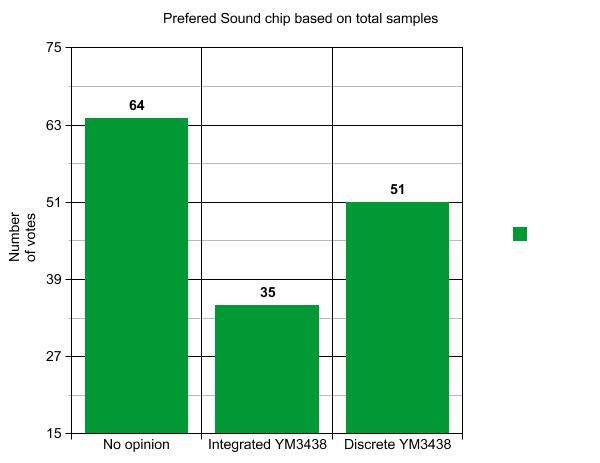
Conclusion:
It was observed through this test that when people were asked to blindly chose between the two choices, they would not find any detectable differences 42% of the times. By opposition when they did make a choice between one or the other, they were just as likely to prefer one or the other. I therefore conclude that for the average user, there would be no significant perceptible difference in using one chip or the other. This can be concluded with an acceptable degree of certitude considering the size of the sampling pool and the distribution of the data.
The practical conclusion of this is that we can assume that the highest sound quality on a genesis is also achievable on a Model 1 machine and not only on the model 2. High quality CCAM audio is no longer something that should be associated strictly with a Model 2. The stand-alone YM3438 chip is just as capable of delivering quality sound as the integrated one.
Possible Caveats
Now this test was limited to a subjective appreciation of musical samples. There are other potential aspects that could complicate the application of the results.
- Wild discrete YM3438 chips not being all created equal: The only way to get these chips in the wild is mostly by ordering them from Chinese part distributors. There is always a possibility of bad batches or bootleg chips being in circulation. I made this test using 1 single chip that I evaluated was a good genuine specimen. While it seems that in my case it turned out very well, there is no data on the reliability of finding these chips in the wild.
-Compatibility issues: My personal experience with the discrete YM3438 was of 100% compatibility in all the games I tried, but this is no more than a dozen games. There are reports of timing incompatibility issues in other games using this chip.
So far issues have been reported in:
-Sonic Spinball.
-Earth worm jim.
-Super fantasy zone.
I am now awaiting to receive a copy of Sonic Spinball to test this myself. I will update this page with my findings.
The good news is that it is possibly a fixable issue but that would make the implantation of the genesis 1 modification even more complicated than it already is.
A few last words
Firstly, once more, thank you to all who contributed with their inputs 😀
In the end it is less complicated to use a CCAM on a model 2, but the adventurous modder who prefers model 1 for whatever reason now has an option to get that nice CCAM sound on a model 1, with no compromise on the sound quality.
Personally I prefer using a discrete YM3438 on a model 1 if only because there are interferences issues on the FC1004 based model 2. This will produce a characteristic buzzing noise that modulates along the activity of the console. This can be heard as a buzz in the beginning of the D&D song included in this test package. A handful of people made mention of it but no more. This is a consequence of the Model 2 ASIC/board layout and the discrete implementation on a model 1 does not suffer from this.
HOWEVER, there is a later version of the Genesis Asic, also known as the GOAC ( genesis on a chip ) which basically integrates everything on the console in a single chip. The integrated 3438 on these does not suffer from noise issues. In fact they have the cleanest output of all the genesis consoles. These can be found exclusively on Model 2 VA4 and Genesis model 3 consoles.
They however have an altered/wrong sound balance between FM and PSG so implementing the CCAM on those requires a little fix.
Edit: Also, sorry in advance if I forgot to mention a relevant link or to name a relevant person in the post. I will add details, references, links and answer question on request.
*********************************************Original Post*********************************
Hey there guys, you know how I like audio comparisons right? :p
Here I have a blind test for you, which of course is a load of fun to do :p
I have a zip file containing audio files in flac format. The download is about 110mb. ( 3 mirrors ) MEGA seems fastest.
https://mega.co.nz/#!WVRnTbaR!IEf8_Gdco3QEu34 … FeQ0TcSleiF6wlM
https://docs.google.com/file/d/0BzsnL20-4a37Z … dit?usp=sharing
http://www.mediafire.com/download/35s2xbs8421 … isBlindTest.zip
They are songs recorded directly from two mystery Sega genesis consoles.
There are 5 songs each recorded twice, for a total of 10 files.
Each version of the song has the suffix A or B, which was assigned randomly and doesn't mean anything.
The date of all files was also reset so you cannot know in what order they have been recorded.
The goal is to listen to each files and state your opinion on which one of each pairs sounds better, or what your favourite is.
If you cannot hear any difference or don't have an opinion just say 'no opinion', this is still a valid response to this test.
Alternatively you could also have opinion on only one pair but not the others.
When you respond, just make a short list of your 5 favorite picks. Something like this for example:
Song1-b Song2-a Song3-b Song4-a Song5-b […]
Song1-b
Song2-a
Song3-b
Song4-a
Song5-b
IMPORTANT! Respond by PM to me!!
Plz do not respond in the thread!!! Your responses might influence others!!
I am trying to keep this as scientific as possible. Please use PM.
I will publish the results and explain what each file was when I have enough responses to have a statistically valid sample.
This will be posted in more than one place, to get more participants.
Thanks in advance!
FM sound card comparison on a Grand Scale!!
The Grand OPL3 Comparison Run.